
Für eine deutsche Übersetzung dieser Seite einfach die Brandenburger Flagge anklicken
 |
Click the Brandenburg Flag for a German translation Für eine deutsche Übersetzung dieser Seite einfach die Brandenburger Flagge anklicken |


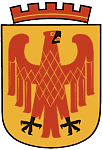 |
Home Towns - Potsdam, GermanyThe New Market Square |
 |



 |
This site is part of our Potsdam, Germany site. Click the left turn sign to get back to the Potsdam Start Site. |


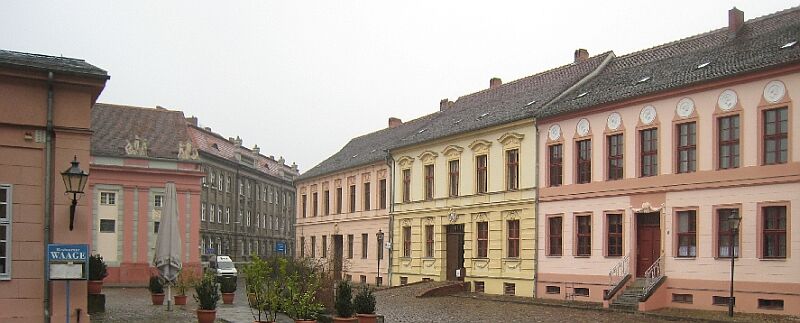
|

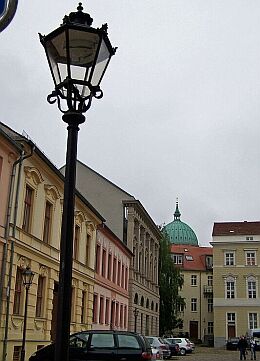 |
Potsdam's New Market Square (Neuer Markt in German) is one of Europe's
best preserved examples of Baroque architecture. Until the 1700s, the square was outside the city walls - an independent market place just 100
yards from one of the city gates. In the mid 1600s, a stable for horses and carriages was added to the market. Systematic development of the area started when Frederick I incorporated the area into the town. Most of the building one can see here today were built between 1755 and 1790. some of the buildings were damaged during World War II, but everything has been restored beautifully. In contrast to the ever changing apparel of the Old Market Square, the New Market Square today looks again just like it was in the late 1800s. |

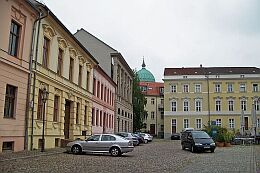 |
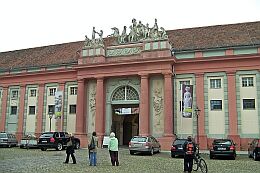 |
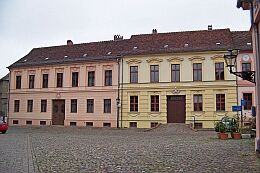
|

| When we walked across the square during our visit in 2007, we didn't even realize the significance of the place and took only very few pictures (see above). To present the square in all its glory, we borrowed a couple of pictures at Wikipedia and PotsdamWiki. |

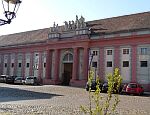 |
Carriage Depot
 This neoclassical building was designed by Royal Architect Andreas Ludwig Krüger and was completed in 1790. It had room for 100 horses, their handlers and a number of stable boys. After 1918, the building was used by the mounted police, from 1940 until 1989 it was degraded to a warehouse. In 2003, the building was complete renovated and now hosts the Prussian-Brandenburg History Museum. |
 |
Am Neuen Markt 1
 The building 1 New Market, built in 1753, represents a style attributed to Frederick the Great. A "Citizen's Palace" was an apartment building for ordinary people with the attire of a palace. Some not so ordinary people were born in this house: Scientist Wilhelm von Humboldt, was born here in 1767 and future Prussian King Frederick Wiliam III, was born in the same place in 1770. From 1788 until 1806, this building hosted the Royal Engineering Academy. |
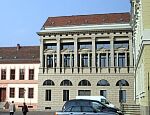 |
Am Neuen Markt 5
 5 New Market is another citizen's Palace. It was built in 1755 by Johann Gottfried Büring, copying an Italian Palazzo. The building was destroyed in the last days of world War II and was rebuilt in the early 2000s. |
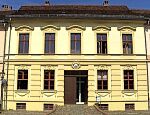 |
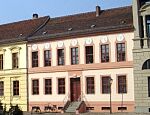 |
Neuer Mark 6 & 7
 6, 7, and 8 New Market are three of the almost 100 houses in Potsdam and Berlin built by Georg Christian Unger. They now host the Einstein Forum and the Moses Mendelssohn Center for European-Jewish Studies. |


Bullet Holes |
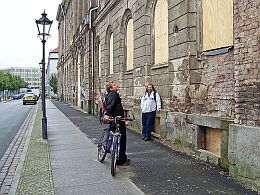 |
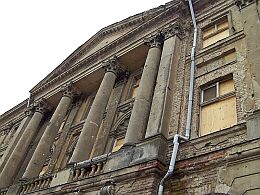 |
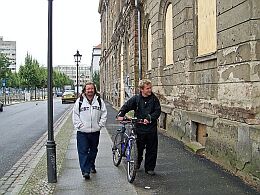
|

General von Steuben MonumentA statue near the market comemorates another war, 250 years ago and 4,000 miles away...
|
 |
"To the German Emperor and the German people by the Congress of the United States of America as a symbol of enduring friendship..."
 General Friedrich Wilhelm von Steuben was a retired Prussian army captain who came to America in 1777 and soon became inspector general of the revolutionary army, turning a bunch of illiterate peasants into a well-oiled war machine. His methods were inovative, like appointing a captain who's sole duty was to curse the recruts in their native language (Steuben didn't speak English). One of his training methods became legend: Among the raw recruits there were men so abysmally untaught that they did not know left from right, and hence could not step off on the left foot as all soldiers should. To teach these lads how to march, he would tie a wisp of hay to the left foot and a wisp of straw to the right; then, setting the men to march, the sergeant would chant, "Hay-foot, straw-foot, hay-foot, straw-foot" —and so on, until everybody had caught on.  March! March! March old soldier march! Hayfoot, strawfoot, Belly-full of bean soup — March old soldier march!  The statue of General Friedrich Wilhelm von Steuben in Potsdam is an exact replica of one that stands in Washington D.C. It was erected in 1911 and in that same year a replica was presented by the Congress of the United States to Kaiser Wilhelm II and the German nation. The statue depicts von Steuben in his military dress uniform surveying the troops at Valley Forge and was given as a symbol of enduring German-American friendship. Since von Steuben was a Prussian Officer, and the residence of the Prussian Kings was Potsdam, the statue ended up here. From 1911 until 1945, it stood in an honored spot near the City Palace, until it was knocked over by bombing near the end of World War II. In 1950, Communist authorities demolished the remains of the castle and melted the statue into salvage. |
In May of 1987, a second copy of the Washington, D.C., statue was unveiled in West Berlin, directly across from the U.S. Army
headquarters. Finally, in spring of 1994, a third statue was brought back to the original Potsdam location. The formal dedication
was held on 28 November 1994, near the only surviving buildings of the City Castle, the imperial stables.
 The text on the 1911 pedestal, now long destroyed, was reproduced on a new plaque unveiled on April 30, 1994. It reads:  "To the German Emperor and the German people by the Congress of the United States of America as a symbol of enduring friendship. Replica of the monument for General Friedrich Wilhelm August Von Steuben. Born in Magdeburg 1730, died in the state of New York 1794. Erected in Washington in grateful recognition of his service to the American People in their struggle for liberty."  The 1994 dedication ceremony in Potsdam was attended by nearly 200 guests including numerous officials of the U.S. Army, Air Force and Navy as well as military and political officials from several other European countries. In addition, many German and American members of the current von Steuben family were also present for the ceremony. |

The canal sustained heavy damage in World War II. There were plans for its reconstruction in the 1950s, but the almost stagnant water turned into a
health risk and thus, the canal was filled up in 1965. Starting in 1999, a
reconstruction project
is underway and by 2016, the 1 mile long Canal will be restored to its old beauty. The canal starts near the State Audit Court (picture above). The pictures below left and right show how the canal looked when we visited it in 2007, the picture in the middle is taken from Wikipedia, showing the latest progress. 
|
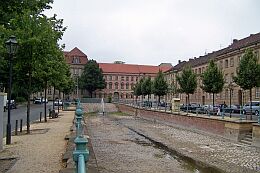 |
 |
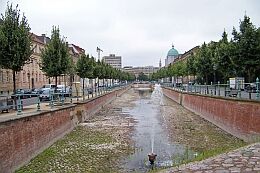
|


 Back to Potsdam Page |
 Back to Home Towns |
 Back to Germany Page |
 Back to English Main Page |
 Back to Start Page |